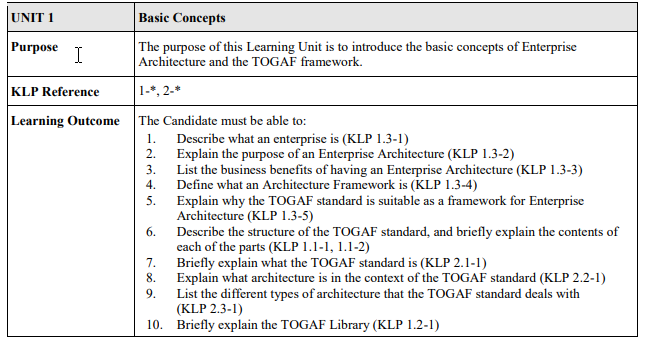TOGAF - 1- Basic Concepts

Enterprise Definition
A collection of organizations that have common goals
What is the purpose of EA?
Optimize processes across the enterprise to to be responsive to change and support business strategy.
Benefits of EA
- Improved operations
- Improved ST and IT operations
- More ROI, reduced risk for future investment
- Faster, simpler, cheaper procurement
Architecture Framework Definition
Foundational set of structures that various architectures are built on. Describe target state with building blocks. Set of tools and common vocabulary. Stndards and compliant products.
Why Use TOGAF?
Developed by whole community. Consistent, reflects needs of stakeholders, best practices, considers current requirements and perceived future needs. Standardizes and de-risks the architeture development process.
Structure of TOGAF
Reflects the structure of an architecture capability within an enterprise.
6 Parts
- Introduction - High-level intro and definition of terms
- Architecture Development Method (ADM) - step-by-step aproach to developing an enterprise architecture
- ADM Guidelines and Techniques
- Architecture Content Framework - Structured metamodel for architectural artifacts, use of reuasble Architecture Building Blocks (ABBs), overview of typical architecture deliverables
- Enterprise Continuum and Tools - Taxonomies and tools to store the output of architecture activities
- Architecture Capability Framework - All the pieces (org, processes, skills, roles, etc.) required to operate architecture function within an enterprise.

What is the TOGAF Standard?
An architecture framework to assist with implementing/using an enterprise architecture. Based on an iterative model and reusable set of archtecture assets.
What is architecture in the context of TOGAF?
Concepts or properties of a system embodied in its elements, relationships, and in the principles of its design and evolution.
The structure of components, their inter-relationships, and the principles and guidelines governing their design and evolution over time.
Types of Architectures that TOGAF deals with
- Business - strategy, governance organization, and processes
- Data - logical and physical data assets and data management resources
- Application - applications to be deployed, their interactions, and their relationships to the core business processes of the organization
- Technology - logical software and hardware capabilities that are required to support the deployment of business, data, and application services; includes IT infrastructure, middleware, networks, communications, processing, standards, etc
Explain the TOGAF Library
A portfolio of guidance material to support the practical application of TOGAF.
- Foundation documents
- Generic Guidance and Techniques
- Industry-Specific Guidance and Techniques
- Organization-specific guidance and techniques